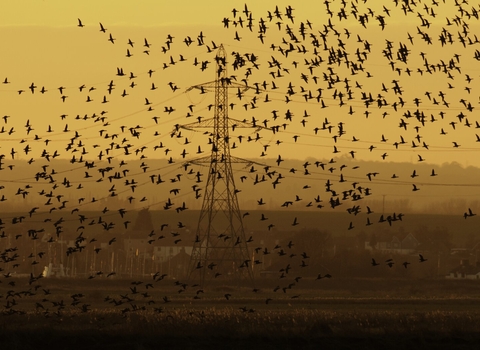Energy infrastructure and the climate and ecological emergencies
The UK and the world face twin climate and ecological emergencies that will have huge social, environmental, and economic costs unless we take urgent action now to prevent the worst impacts. Making the transition from fossil fuels to zero and low carbon energy sources is vital but must not come at the expense of the natural environment that underpins our societies and economies. New energy infrastructure to support the transition to a net zero society must be planned, designed, and built with protecting and restoring biodiversity and natural ecosystems as an essential requirement.
Strategic planning for energy infrastructure
We support a coordinated approach to planning, design, and construction of energy cables and grid infrastructure to reduce environmental and consenting risks as well as impacts on local communities. The existing framework within which offshore wind developers work does not support the level of coordination needed to ensure the environment and wildlife are adequately considered and impacts minimised.
With the amount of energy infrastructure expected in East Anglia, planning of offshore and onshore grid infrastructure must be holistic to ensure the marine environment, and especially our vitally important network of Marine Protected Areas, receives the same consideration and protection as the terrestrial environment in the planning of new energy infrastructure.
Norwich to Tilbury
Norwich to Tilbury is a proposal by National Grid Electricity Transmission (National Grid) to reinforce the high voltage power network in East Anglia between the existing substations at Norwich Main in Norfolk, Bramford in Suffolk and Tilbury in Essex, as well as connect new offshore wind generation.
As a major infrastructure development, Norwich to Tilbury has the potential to impact on wildlife through the route selected and the design and construction of the scheme. Given the scale of the scheme and its potential for ecological impacts, we are engaging with National Grid – the scheme’s developer – and other ecological stakeholders with the aim of ensuring any adverse impacts on biodiversity and ecology are minimised and any opportunities for the scheme to support nature’s recovery are maximised.
We will be responding to consultations on the proposals with a focus on the potential impacts on wildlife and ecology and calling on National Grid to ensure that best practice is followed in the consideration of ecological impacts in the planning and design of the scheme, including its routing.
Impacts other than ecology
We cannot comment on impacts outside of those on wildlife (biodiversity and ecology), which fall outside of our charitable purpose. While we recognize that there are significant concerns about the landscape and visual impacts of the scheme, we are unable to include these in our representations on the scheme’s ecological impacts.
Opposition to Norwich to Tilbury
We are aware of significant public and political opposition to Norwich to Tilbury from East Anglian MPs in the Off-Shore Electricity Grid Task Force (OffSET) and a petition[1] calling for Government to require National Grid to pursue an alternative offshore cabling solution.
We support calls for a strategic approach to electricity transmission grid planning for the East of England, but urge a cautious, evidence-led, and holistic approach to planning of offshore and onshore grid infrastructure to ensure the marine environment receives the same consideration and protection as the terrestrial environment in the planning of new energy infrastructure.
Offshore cabling and other infrastructure that would be needed to deliver an ‘offshore ring-main’ solution would itself have potential for significant ecological impacts that must not be ignored in the rush to place new energy infrastructure ‘out of sight and out of mind’.
[1] SAY NO TO 180km of Essex Suffolk Norfolk pylons - and build a strategic offshore grid instead | 38 Degrees

